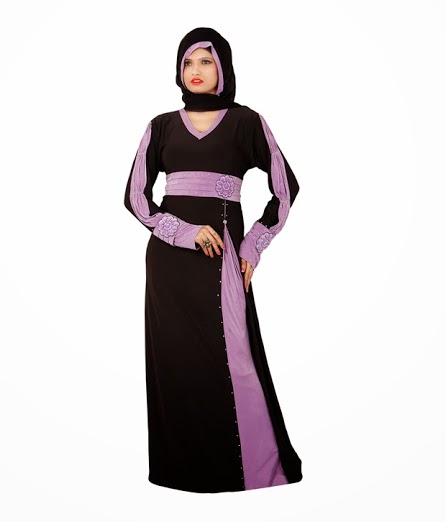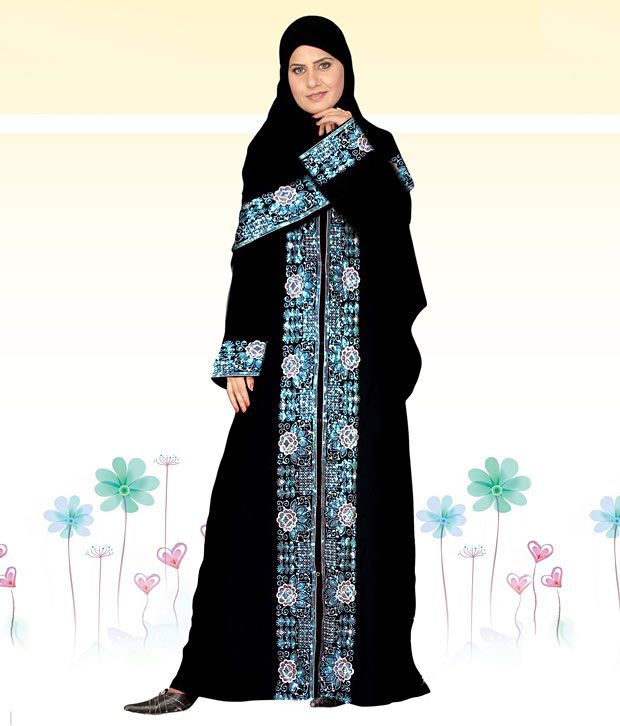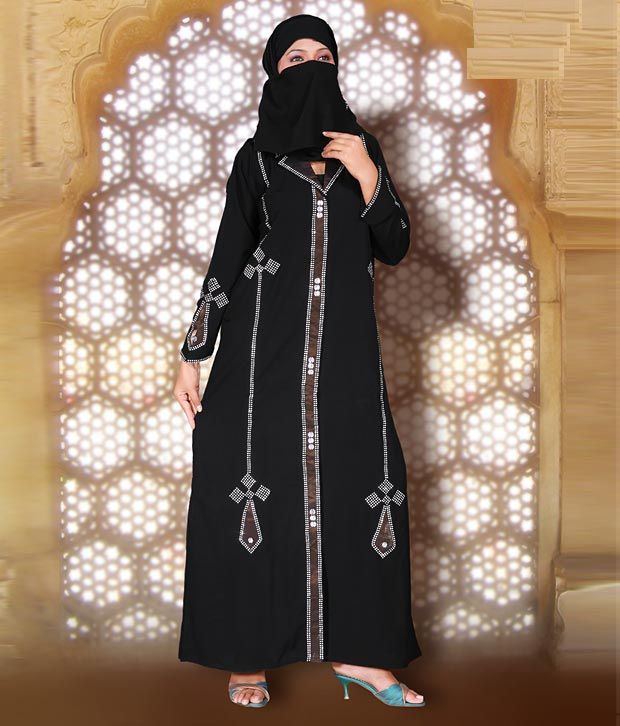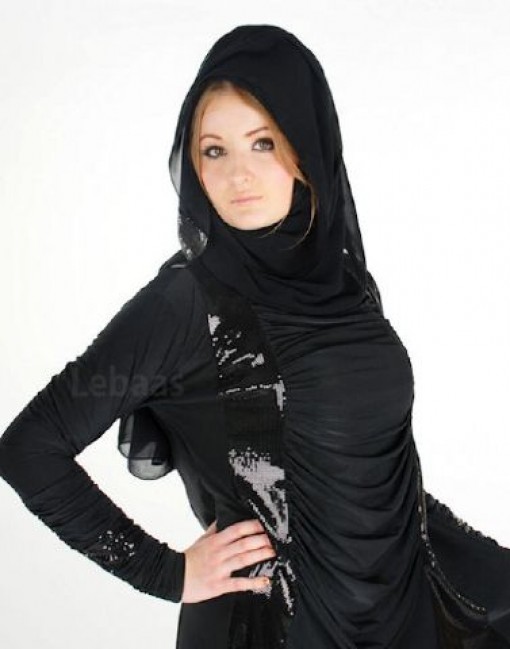About Burka Design
Source (google.com.pk)
A long, flowing garment that covers the whole body from head to feet, the burka, also known as burqa or abaya, is an important part of the dress of Muslim women in many different countries. Some burkes leave the faces uncovered, but most have a cloth or metal grid that hides the face from view while allowing the wearer to see. The exact origin of the burka is unknown, but similar forms of veiling have been worn by women in countries such as India, Pakistan, Saudi Arabia, and Afghanistan since the beginning of the Muslim religion in 622 C.E. The Koran, the holy book of Islam, directs believers to cover themselves and be humble before God. Different societies and religious leaders have interpreted this command of the Koran in many different ways, often requiring both men and women to cover their heads as a sign of religious respect. Some Muslim societies have required women to cover themselves more modestly than men, covering not only their heads but also most of their bodies and even their faces. The burka is one example of very modest clothing worn by Muslim women.
The burka has mainly been worn in very conservative Muslim cultures, which often restrict the movement and power of women. Young girls are not required to cover themselves with a burka, but at puberty or marriage they begin to wear it. While women do not wear the burka while they are home with their families, they are required to wear it when they are in public or in the presence of men who are not family members. In many places the burka was first worn as a sign of wealth and leisure, because a woman could not easily work while wearing the long garment. Though the burka often appears confining and limiting to Western eyes, many devout Muslim women choose to wear the long veil. Some say that the coverage of the burka gives them a privacy that actually makes them feel freer to move about in society. However, others say that even though the burka protects women from the staring eyes of strange men, it does not prevent the wearer from being touched or pinched by passing men. Also, many Muslim women who live in very conservative societies are forced to wear the burka whether they want to or not, and many have been punished harshly for refusing to cover themselves as their authorities demand
Abayas is a Muslim culture for Muslim girls and a common wear upper dress in all Muslim countries like Iran, Iraq, India, Pakistan, Arab, Egypt, Turkey, Sudan etc but this culture is becoming a fashion or trend that mostly western countries also preferring these Abaya and Jilbab dresses as upper wear. Abayas and Jilbabs are always incomplete with out scarf and Hijab. Here we are going to share best abaya designs of M&A brand which are showing in a fashion show which may be held by Crystal Lized. In thiscrystal lized fashion show models are showing latest designs of Arabic Abaya 2010 2011.
This Abaya fashion show starts a new trend instead of traditional abaya culture. In this Arabia Abaya style the abaya designer introduced a built-in (pre-designed) trouser with this abaya, mean this abaya dress have a complete set contains Trouser, Upper wear like open shit (or long coat) and hijab. The stylish abaya have silver embroidery work on its border, sleeves and hijab.
It’s a embroidered abaya in open shirt designs. This embroidered Arabic abaya have motif and zari work. These types of bridal abaya looks gorgeous with scarf instead of hijab.
Latest design of bridal abaya 2010 in net (transparent) cloth. This abaya have red lace border which is giving a stunning impression.
Long Abaya in contrast button style. Abaya In lining style are most preferred by Iranin and Arab Girls specially teen age girls. The Abaya has black scarf.
Colorful Threats of casual baggy abaya is giving a modish look. Abaya have vee Neckline and scarf is also decorated with contrast design. These types of abayas may liked by Egyptian and Iraqi Girls. Mostly Arabic Girls preferred these types of abaya for party wear.
It’s a trendy abaya looking modish with stylish pocket style. This abaya have beautiful contrast hijab. These types of Hijabs and abayas are mostly wear in parties and young girls preferred these styles which follows the current fashion.
It’s an Arabic Baggy abaya which have silver belly belt giving a stylish look. This abaya also giving a Jal-pari (fish style) abaya look because of it’s a transparent sleeves and side area. Model on Crystal LizedArabian Creation Award fashion runway is looking pretty with trouser pant, stylish abaya andgorgeous hijab.
Iranian traditional style of abaya for winter season has beautiful neck line. This abaya have beautiful hijab. These types of abaya can wear as casual, formal and party wear.
Burka Design Abaya Designs 2014 Dress Collection Dubai Styles Fashion Pics Photos Images Wallpapers

Burka Design Abaya Designs 2014 Dress Collection Dubai Styles Fashion Pics Photos Images Wallpapers

Burka Design Abaya Designs 2014 Dress Collection Dubai Styles Fashion Pics Photos Images Wallpapers

Burka Design Abaya Designs 2014 Dress Collection Dubai Styles Fashion Pics Photos Images Wallpapers

Burka Design Abaya Designs 2014 Dress Collection Dubai Styles Fashion Pics Photos Images Wallpapers

Burka Design Abaya Designs 2014 Dress Collection Dubai Styles Fashion Pics Photos Images Wallpapers

Burka Design Abaya Designs 2014 Dress Collection Dubai Styles Fashion Pics Photos Images Wallpapers

Burka Design Abaya Designs 2014 Dress Collection Dubai Styles Fashion Pics Photos Images Wallpapers

Burka Design Abaya Designs 2014 Dress Collection Dubai Styles Fashion Pics Photos Images Wallpapers

Burka Design Abaya Designs 2014 Dress Collection Dubai Styles Fashion Pics Photos Images Wallpapers

Burka Design Abaya Designs 2014 Dress Collection Dubai Styles Fashion Pics Photos Images Wallpapers

Burka Design Abaya Designs 2014 Dress Collection Dubai Styles Fashion Pics Photos Images Wallpapers

Burka Design Abaya Designs 2014 Dress Collection Dubai Styles Fashion Pics Photos Images Wallpapers
Burka Design Abaya Designs 2014 Dress Collection Dubai Styles Fashion Pics Photos Images Wallpapers

Burka Design Abaya Designs 2014 Dress Collection Dubai Styles Fashion Pics Photos Images Wallpapers

Burka Design Abaya Designs 2014 Dress Collection Dubai Styles Fashion Pics Photos Images Wallpapers

Burka Design Abaya Designs 2014 Dress Collection Dubai Styles Fashion Pics Photos Images Wallpapers

Burka Design Abaya Designs 2014 Dress Collection Dubai Styles Fashion Pics Photos Images Wallpapers

Burka Design Abaya Designs 2014 Dress Collection Dubai Styles Fashion Pics Photos Images Wallpapers

Burka Design Abaya Designs 2014 Dress Collection Dubai Styles Fashion Pics Photos Images Wallpapers

Burka Design Abaya Designs 2014 Dress Collection Dubai Styles Fashion Pics Photos Images Wallpapers

Burka Design Abaya Designs 2014 Dress Collection Dubai Styles Fashion Pics Photos Images Wallpapers

A Kaftan dress and amanis looks really nice and that’s why a lot of Muslim women love it. They don’t just wear it because its a cultural thing but because it is nice and comfortable.
ReplyDelete